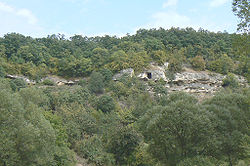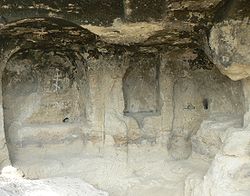
Albotin Monastery
Encyclopedia



Bulgaria
Bulgaria , officially the Republic of Bulgaria , is a parliamentary democracy within a unitary constitutional republic in Southeast Europe. The country borders Romania to the north, Serbia and Macedonia to the west, Greece and Turkey to the south, as well as the Black Sea to the east...
n medieval cave monastery
Cave monastery
A cave monastery is a monastery built in caves, with possible outside facilities. St. Anthony the Great known as the founder of monasticism lived in a cave.- List of cave monasteries :*Albania**St...
on the territory of Kula
Kula, Bulgaria
Kula is a town in northwestern Bulgaria. It is the administrative centre of Kula Municipality part of Vidin Province. Located just east of the Serbian-Bulgarian border, it is the third largest town in the province after Vidin and Belogradchik. Kula lies 30 kilometres west of Vidin and 13...
bishopric of Vidin
Vidin
Vidin is a port town on the southern bank of the Danube in northwestern Bulgaria. It is close to the borders with Serbia and Romania, and is also the administrative centre of Vidin Province, as well as of the Metropolitan of Vidin...
Diocese of Bulgarian Orthodox Church
Bulgarian Orthodox Church
The Bulgarian Orthodox Church - Bulgarian Patriarchate is an autocephalous Eastern Orthodox Church with some 6.5 million members in the Republic of Bulgaria and between 1.5 and 2.0 million members in a number of European countries, the Americas and Australia...
, in the locality Albotin (Albutin) along river Topolovets between villages Gradets and Rabrovo, nearby village Deleyna.
The monastery complex was built in the limestone
Limestone
Limestone is a sedimentary rock composed largely of the minerals calcite and aragonite, which are different crystal forms of calcium carbonate . Many limestones are composed from skeletal fragments of marine organisms such as coral or foraminifera....
rock massif on the northern side of the river, on some 25 metres height, using shallow natural caves and rock sheds, with additionally hewn premises and niches with religious and every-day purposes. The monastery is reached by a steep and narrow sandy pathway in the beginning of which was constructed a water tap, known as Haiduk cheshma. Being easily accessible, in later times the cave monastery was used by shepherds and stone-cutters as a shelter, and robbed and vandalized by treasure-hunters.
Albotin monastery was active in the 14th century according to the account of the preserved fragments of fresco
Fresco
Fresco is any of several related mural painting types, executed on plaster on walls or ceilings. The word fresco comes from the Greek word affresca which derives from the Latin word for "fresh". Frescoes first developed in the ancient world and continued to be popular through the Renaissance...
es and inscriptions, as well as adornments (earrings, tabs, bracelets) found in the 29 discovered Christian graves. The large number of burials of laity
Laity
In religious organizations, the laity comprises all people who are not in the clergy. A person who is a member of a religious order who is not ordained legitimate clergy is considered as a member of the laity, even though they are members of a religious order .In the past in Christian cultures, the...
among the clergymen is an evidence that the monastery was a reputable sanctuary and a desired place for the eternal peace of its donors. Among the scarce historic records, it is noteworthy the mentioning of the nowadays non-existent village Altovin in a registry of Vidin kaaza (district) from year 1560.
The monastery complex consists of eight premises in a row, with the church located in the middle sector, in the most concave part of the rock massif curve. The church contains three nave
Nave
In Romanesque and Gothic Christian abbey, cathedral basilica and church architecture, the nave is the central approach to the high altar, the main body of the church. "Nave" was probably suggested by the keel shape of its vaulting...
s and is oriented according to the canon from west to east, its southern and southwestern parts being fully devastated. The presence of a baptisterium
Baptisterium
In classical antiquity, a baptisterium was a large basin installed in private or public baths into which bathers could plunge, or even swim about. It is more commonly called natatorium or piscina....
bespeaks of the temple being used not only for monastic praying but also for public liturgies. In the north-western of the monastery, there is a second floor, containing the second largest premise of the monastery, which was presumably used for a refectory
Refectory
A refectory is a dining room, especially in monasteries, boarding schools and academic institutions. One of the places the term is most often used today is in graduate seminaries...
. In the western part of the monastery other cloiser premises were located: the monks cells, kitchen, cellar, store-rooms. Two water tanks can also be seen.
The name of the monastery church is unknown, but there are suppositions that it was devoted to the Resurrection of Jesus
Resurrection of Jesus
The Christian belief in the resurrection of Jesus states that Jesus returned to bodily life on the third day following his death by crucifixion. It is a key element of Christian faith and theology and part of the Nicene Creed: "On the third day he rose again in fulfillment of the Scriptures"...
, due to the preserved old tradition of playing chain dances (horo)
Bulgarian dances
Bulgarian folk dances are intimately related to the music of Bulgaria. This distinctive feature of Balkan folk music is the asymmetrical meter, built up around various combinations of 'quick' and 'slow' beats...
in the memory of the deceased on the second day of Easter. This custom is widely observed by Vlachs
Vlachs
Vlach is a blanket term covering several modern Latin peoples descending from the Latinised population in Central, Eastern and Southeastern Europe. English variations on the name include: Walla, Wlachs, Wallachs, Vlahs, Olahs or Ulahs...
who hang the portraits of their dead relatives on the branches of a venerable tree in the meadow under the monastery. Each of the chain dances played before noon-time is devoted to a separate dead man, and the afternoon dances are devoted to the living people. Bulgarians and Vlachs pick up dictamnus
Dictamnus
Dictamnus is a genus of flowering plant in the family Rutaceae, with a single species, Dictamnus albus. It is known variously as Burning-bush, False Dittany, White Dittany, Gas-plant and Fraxinella. It is a perennial herb, native to southern Europe, north Africa and throughout...
and hand out a sprig per each deceased relative.
The Albotin cave monastery was announced monument of culture in the Bulgarian state gazette on 28 December 1927, Issue 221, and on 26 December 1969, Issue 100.
See also
- Aladzha MonasteryAladzha MonasteryAladzha Monastery is a medieval Orthodox Christian cave monastery complex in northeastern Bulgaria, 17 km north of central Varna and 3 km west of Golden Sands beach resort, in a protected forest area adjacent to the Golden Sands Nature Park.The monastery caves were hewn into a 25-m high...
- Basarbovo MonasteryBasarbovo MonasteryBasarbovo Monastery - the Monastery of Saint Dimitar Basarbowski - is a bulgarian-orthodox cave monastery near the city of Ruse in north-eastern Bulgaria...
- Rock-hewn Churches of IvanovoRock-hewn Churches of IvanovoThe Rock-hewn Churches of Ivanovo are a group of monolithic churches, chapels and monasteries hewn out of solid rock and completely different from other monastery complexes in Bulgaria, located near the village of Ivanovo, 20 km south of Rousse, on the high rocky banks of the Rusenski Lom, 32 m...

